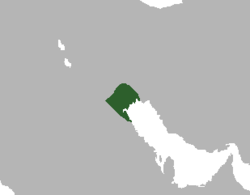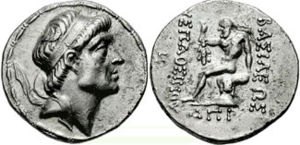- Characene
-
- Mesene redirects here. For the genus of metalmark butterflies, see Mesene (butterfly).
Characene, also known as Mesene (Babylonian Judeo-Aramaic: חבל ימא Ḥevel Yama "Sealand"[1]), was a kingdom within the Parthian Empire at the head of the Persian Gulf. Its capital was Charax Spasinou, "The Fort of Hyspaosines". The city was an important port in the trade from Mesopotamia to India and provided port facilities for the great city of Susa, further up the present day Karun River.
Characene was founded around 127 BC under Aspasine, known in Classical writings as Hsypaosines, formerly a satrap installed by Antiochus IV Epiphanes. Characene existed through the break-up of the Seleucid Empire and continued as an essentially independent kingdom under the Parthians, until it was conquered by the Sassanians in the beginning of the 3rd century CE. At one point Characene included Tylos, the present day country of Bahrain.
After the Parthian conquest it remained a semi-autonomous country with its own kings. It disappeared as a separate kingdom with the fall of the Parthian Empire.
Trajan, the Roman emperor, visited Charax in 116 AD, during his invasion of Parthia, and watched the ships leaving for India. He reportedly lamented the fact that he was not younger so that he could, like Alexander, have gone there himself.
The kings of Characene are mainly known by their coins, consisting mainly of silver tetradrachms with Greek and later Aramaic inscriptions. These coins are dated (following the Seleucid era) providing a secure framework for the chronological placements of the kings.
Kings of Characene
- Hyspaosines c. 127-124 BC
- Apodakos c. 110/09-104/03 BC
- Tiraios I 95/94-90/89 BC
- Tiraios II 79/78-49/48 BC
- Artabazos 49/48-48/47 BC
- Attambelos I 47/46-25/24 BC
- Theonesios I c. 19/18
- Attambalos II c. 17/16 BC - AD 8/9
- Abinergaos I 10/11; 22/23
- Orabazes I c. 19
- Attambalos III c. 37/38-44/45
- Theonesios II c. 46/47
- Theonesios III c. 52/53
- Attambalos IV 54/55-64/65
- Attambalos V 64/65-73/74
- Orabazes II c. 73-80
- Pakoros (II) 80-101/02
- Attambalos VI c. 101/02-105/06
- Theonesios IV c. 110/11-112/113
- Attambalos VII 113/14-117
- Meredates c. 131-150/51
- Orabazes II c. 150/51-165
- Abinergaios II (?) c. 165-180
- Attambalos VIII c. 180-195
- Maga (?) c. 195-210
- Abinergaos III c. 210-222
Further reading
- ^ Babylonian Talmud - Kiddushin 72.
- Schuol, Monika: Die Charakene. Ein mesopotamisches Königreich in hellenistisch-parthischer Zeit (= Oriens et occidens 1), Stuttgart 2000, ISBN 3-515-07709-X
- Sheldon A. Nodelman, A Preliminary History of Charakene, Berytus 13 (1959/60), 83-121, XXVII f.,
- Hansman , John: "CHARACENE and CHARAX" , Encyclopaedia Iranica, Online Edition,Center for Iranian Studies Columbia University,December 15, 1991, available at WEB ADDRESS OF THE ARTICLE, Access date :14 September 2011.
Categories:- Parthian Empire
- History of Iran
- History of Iraq
- History of Kuwait
- History of Bahrain
- Sites along the Silk Road
- Seleucid Empire successor states
Wikimedia Foundation. 2010.


